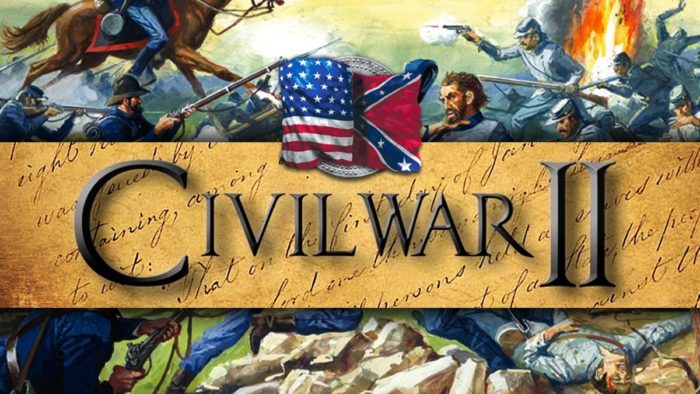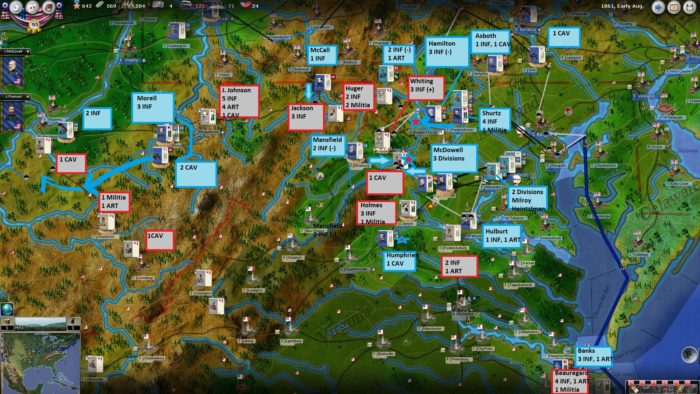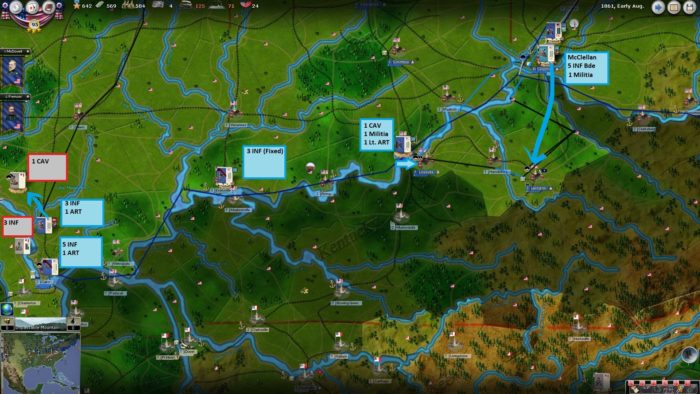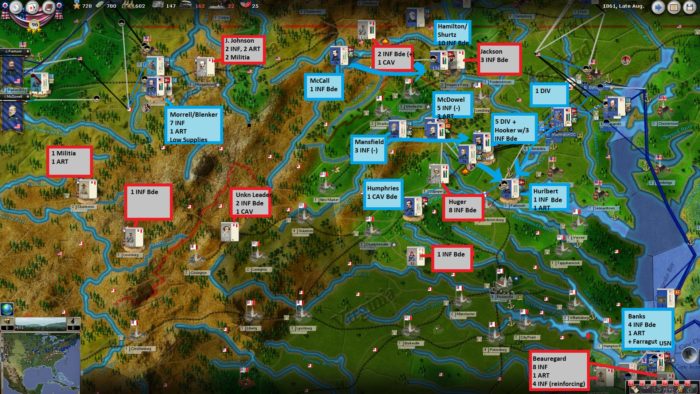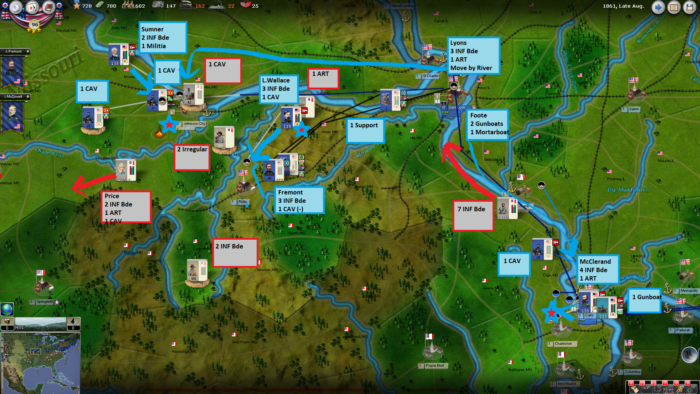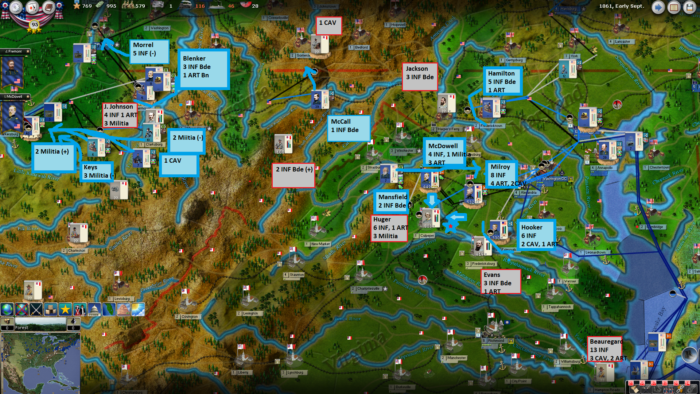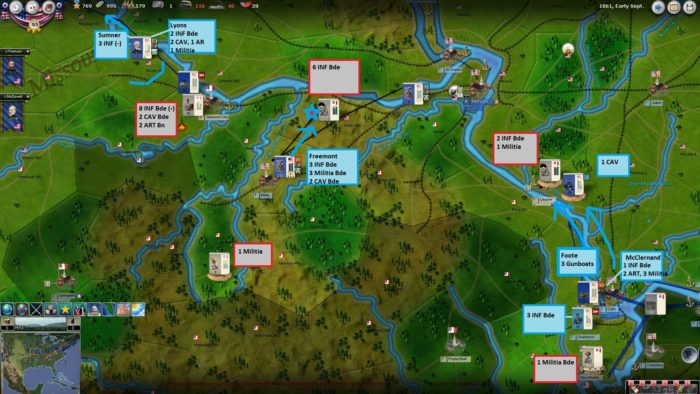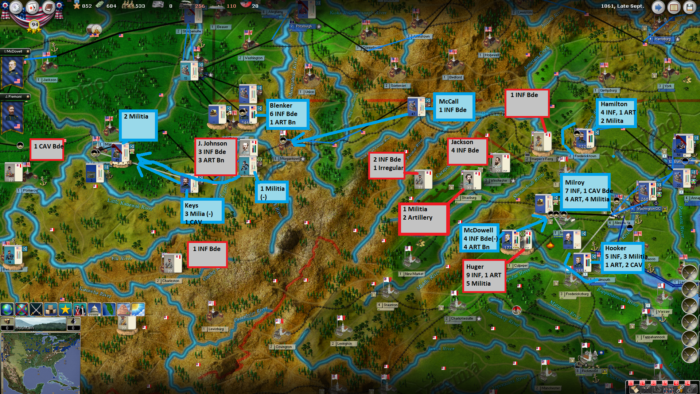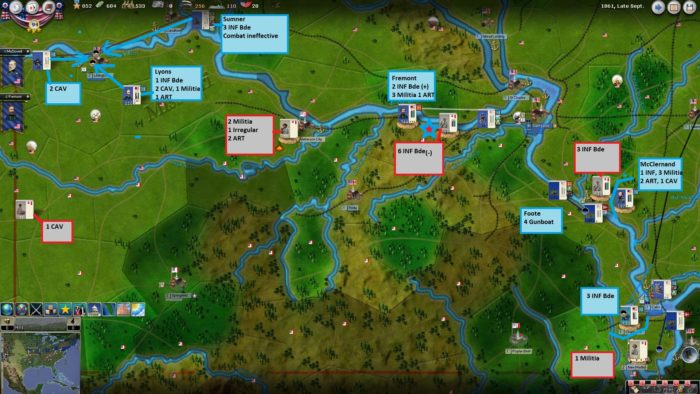Civil War II – An After Action Report! Part 4
By August, I am becoming concerned with how fast the CSA is mobilizing. Its army is now at 82% of the US army strength. While I am concentrating on building up the Union navy, I cannot afford to have an almost equal CSA army and led by superior generals. My other concern is that the Union artillery corps appears underdeveloped, with many of my units lacking artillery support. Consequentially, I am going to slow down the naval build up, and try to increase the rate of the Union army’s build up. Note: Historically the Union and Confederate were approximately the same size at this point in the war, but the Union army subsequently grew much larger as the war progressed. According to the National Park Service, “In July 1861, the two armies were nearly equal in strength with less than 200,000 soldiers on each side; however at the peak of troop strength in 1863, Union soldiers outnumbered Confederate soldiers by a ratio of 2 to 1. The size of Union forces in January 1863 totaled over 600,000. Two years later, that number had not changed dramatically for the Union Army but had dropped to about 200,000 for the Confederate Army.”
By: Tripoli,
1-15 August 1861 (Turn 9)
Strategic Overview
National Moral: 95 (Defeat at 40)
Victory Point: 645
Foreign Intervention: 24
CSA Mil. Power: 82% of US Army
13% of US Navy
Economic Overview
Cash: $ 1,344,000
Militia: 583
War Supplies: 244
Rail Points: 228
River Points: 85
Weather
Eastern Theater: Clear
Western Theater: Clear
Trans-Mississippi: Clear
Blockade
- Chesapeake Bay and Wilmington, NC are blockaded
- The Atlantic and Gulf of Mexico distant blockade are 25% effective
Events
- Camp Dick Robinson-Union can enter parts of Kentucky
- Federal Income tax begun
- Confiscation Act
Government Decisions
Build armories in New England and Connecticut
Builds
4 Artillery units, 2 Infantry Bde 1 Supply
Notes:
The “Camp Dick Robinson” event fires, allowing a small Union force to enter parts of Kentucky without violating its neutrality. (Historical Note: In late May 1861, Unionist Kentuckians obtained muskets and distributed them to loyalists in the state. These loyalists then appealed to Lincoln for assistance. Lincoln agreed to support the raising of 10,000 Kentuckians in the state. These troops formed at Camp Dick Robinson. Emboldened by Lincoln’s actions, Unionist in an August 1861 special election won veto-proof majority in the Kentucky legislature. Although it remained officially neutral for another month, Union dominance in the legislature put Kentucky on the road to joining the Union. When Confederate forces seized Columbus, KY in early September, the state entered the war on the side of the Union).
Military
Despite Mansfield’s victory on 20 July at Strasburg, his force failed to advance towards Harper’s Ferry and safety. Now the situation with his troops is dire, as the Union force under Hamilton failed to seize Harper’s Ferry and a strong Confederate division under Whiting is now blocking Mansfield’s path to the northern Shenandoah. The only avenue to safety now is for Mansfield to reach McDowell’s lines. This path is blocked by a single Confederate cavalry brigade. To open this route, McDowell, with one division of troops and the Army of the Potomac (AotP) reserve attack the cavalry unit to clear a path for Mansfield, whose weakened troops are unable to attack. The remaining units of the AotP will dig in at Manassas and await reinforcements from Washington. Hulbert will dig in outside Fredericksburg and await reinforcements and the single cavalry unit under Humphries will destroy the rail lines linking the Confederates at Culpeper, VA with the rest of the state. Hopefully, this will encourage the Confederates at Culpeper to withdraw from that position (Image 14).
In the Shenandoah, forces under Shurtz, Asboth and Hamilton are directed to move on Harper’s Ferry while McCall moves to tie down Jackson by securing a section of the B&O line opposite the Confederate forces.
Banks continues to dig in at Norfolk. He is slightly outnumbered by Beauregard, but Union entrancements should even the odds. A single artillery unit is sent to Annapolis for transport to Banks.
In West Virginia, Morell is directed to dig in, as he has insufficient forces to fight Joe Johnson. To clear the Confederate cavalry unit near Parkersburg away from the Ohio River, I send a cavalry unit behind them to cut their LOCs. This should encourage them to withdraw without fighting.
In Kentucky, I push Union forces from Cincinnati down to Lexington. Additional forces are sent to Louisville from New Albany. The Union will set up a depot there to help with supplying my forces as they move into central Kentucky.
In Missouri, Fremont (3-3-1) arrives and forms the Army of the West. The lack of popular support in the state means that it is difficult to identify the location of Confederate forces. In particular, Sterling Price is undetected. His army appears scattered in seven locations throughout north-central Missouri (Image 16). This provides an opportunity to attack and defeat these detachments separately. I send Lyons to clear an infantry brigade that is along the rail line SSW of St. Louis. Meanwhile, Lew Wallace and Freemont will take Rolla, MO, while Sumner cautiously advances towards Jefferson City to threaten it from the west.
In the far west, the two units of Texas cavalry retreating from Dallas continue heading north towards Kansas and safety. Enroute, they seize two pro-Confederate settlements in the Indian Territory (modern-day Oklahoma). While militarily insignificant, their loss may encourage the Confederates to send forces to this area.
Results
- The suspension of Habeas Corpus in Washington DC was unsuccessful.
- Farragut engaged and damaged a Confederate squadron in the Chesapeake.
- Pickens, FL (Pensacola) and Norfolk are besieged. Norfolk defenses are breached.
- Generals Hooker, Burnside and Halleck become available
- Rolla, MO is captured by the US.
- Freemont, Asboth, Shurtz and Hamilton reverted to a defensive stance and did not advance.
- CSS SUMTER attempted to engage Union shipping in the Atlantic but was driven off.
16-30 August 1861 (Turn 10)
Weather
- Eastern Theater: Clear
- Western Theater: Clear
- Trans-Mississippi: Clear
Blockade
- Chesapeake Bay and Charleston SC are blockaded
- The Atlantic and Gulf of Mexico distant blockade are 25% effective
Events
- Federal Income tax begun
- Confiscation Act Passed. (Historical Note: The Confiscation Act of 1861 authorized the confiscation of any Confederate property, including slaves, by Union forces
Government Decisions
- US expands the rail and transportation pool
- The US issue war bonds, raising $800,000 and creating 1% deflation, but with a 25 VP loss.
Builds
I emphasize army builds, ordering 3 Supply wagons, 1 Naval Transport, 2 Artillery, 2 Infantry Brigades, 1 Marine Brigade and one 1 Engineer unit.
Military
In the Eastern Theater, Mansfield has yet to reach the safety of McDowell’s lines. I have him continue to retreat east through the escape route held open by McDowell (Image 17). Hulbert, lacking the strength to attack Fredericksburg from across the Rappahannock, begins to entrench on the north side of the river. Two divisions, one under General Hooker are ordered to reinforce him. The Union cavalry under Humphries reached the rail SW of Culpeper, but failed to destroy it. He is directed to destroy the rail line before moving north to safety. (Image 17).
At Harper’s Ferry, Hamilton and Shurtz failed to dislodge the Confederates from the town. However, they are reported to have a 3:1 advantage over Confederate forces under Jackson located there. This should give them enough advantage to push him out. McCall, with one infantry brigade is ordered to move west along the B&O rail line to clear Confederate forces in the area and to join up with Hamilton in Harper’s Ferry.
Banks remains besieged in Norfolk. I am rushing reinforcements to him there, as he is tying up Beauregard and four divisions of Confederate troops. Beauregard’s absence from the Manassas area was critical for the success of the Union advance here, so keeping him tied down in Norfolk is very useful.
The situation in West Virginia is stalemated. Although Morrell prevailed against Joseph Johnson in Morgantown, his forces are low on supplies, and unable to exploit the victory. Additional troops are sent to Morrell to reinforce an effort to dislodge the Confederates from Johnson’s base in Charleston, WV.
In the Missouri area, a Confederate force crossed the Mississippi and seized the town of Chester, IL in July. Although this force was heavily damaged during the crossing by Foote’s gunboats, it has moved back across the river and reinforced another force that is moving up the Missouri bank of the Mississippi towards St. Louis. In central Missouri, Price appears to have scattered his army into five elements. His main body is reported heading west towards Kansas. Although I don’t believe that his main body is moving west, the fact that it is scattered gives me an opportunity to destroy one or more elements in detail. A Union force of four infantry brigades with artillery support is sent from Cairo, IL, across the Mississippi to seize Charleston, MO. This will cut the LOC of the Confederate force moving towards St. Louis along the banks of the Mississippi. Foote’s gunboats will sweep down the river and clear out any Confederate naval forces that may be supporting this force before establishing a blockade at Cairo. This should compel the Confederate force to withdraw back south. Meanwhile, Lyons will duplicate his earlier move against Jefferson City, advancing against it by an amphibious operation via the Missouri River. As Jefferson City is reported lightly held, his forces should readily capture it. Sumner, with a division-sized force will reinforce Lyons at Jefferson City. This will give the Union two Infantry and one cavalry division, which should be a match for any of the Confederate forces. (Image 18). Meanwhile, Fremont will hold Rolla with his division sized force. Lew Wallace, with a second division will join him.
If these movements are successful, by month’s end there should be four divisions of Union forces with interior lines and railroad and river LOCs positioned to move against either against Price in Central Missouri or against the Confederate force in eastern Missouri that is partially isolated by Foote and a Union force at Charleston, MO (Image 18). Ideally, this superior force with interior lines should force both Confederate forces to withdraw to the southern part of the state to avoid being engaged by superior Union forces.
1-15 September 1861 (Turn 11)
Strategic Overview
National Moral: 95 (Defeat at 40)
Victory Point: 769
Foreign Intervention: 28
CSA Mil. Power: 91% of US Army
15% of US Navy
Economic Overview
Cash: $ 1,452,000
Militia: 607
War Supplies: 265
Rail Points: 246
River Points: 55
Weather
Eastern Theater: Mud in WV
Western Theater: Mud in KY, TN, MS, parts of AL, FL, GA
Trans-Mississippi: Mud in MO, Northern AR
Blockade
- Chesapeake Bay and Charleston, SC are blockaded
- The Atlantic and Gulf of Mexico distant blockade are 25% effective
Events
- 16 August-Norfolk falls
- 16 August-Manassas Falls to Union forces
- 16 August-Battle of Harper’s Ferry. Hamilton defeated by Jackson. 14000 US 13607 CSA engaged, Losses: 1629 US v. 1104 CSA
- 20 August-Tucson, AZ territory falls to CSA.
- 23, 29 August-Battle of Clarksburg. Joseph Johnson defeats Morrell. 6942 US v. 13125 CSA engaged. Losses: 1780 US v. 900 CSA
- 26 August-Battle of Pendleton, WV-CSA defeats McCall. 3453 US v. 3720 CSA engaged, Losses: 245 US v. 153 CSA
- 30 August-Battle of Jefferson City. CSA defeats Lyons. 13628 US v. 6240 CSA engaged. Losses: 1691 US 614 CSA
- Sumner, Griffin, Keys, Runyon issued conflicting orders
- Humphries destroyed the CSA rail line SW of Culpeper
- Farragut lost 2 ships bombarding Beauregard.
- Confederacy is building arsenals in LA, AL
- Union public support up to 38% in Baltimore and Washington. US public support only 13% in St. Louis
Government Decisions
- US expands the rail and transportation pool
Builds
- 2 River Ironclads, 1 artillery and 1 Infantry Brigade are ordered.
Notes:
At this point in the game, the CSA has lost 11,000 men and the US has lost 12,184, but taken 3600 prisoners. In the long term, this loss ratio is favorable for the US. In the short term, I am becoming concerned with the strategic situation. The Confederate Army is now 91% of the size of the Union Army, so the Union army is too small to begin to execute my strategy. Additionally, the Foreign Intervention Score increasing to 28% is concerning. I am going to have to lower that, or risk the European powers coming into the war.
Military
In the Eastern Theater, the string of losses at Clarksburg, Harper’s Ferry and Norfolk have hurt the Union. McCall’s defeated force will retreat towards Parkersburg, while Morrell will defend Fairmont. I will likely have to build a depot there before I can begin to drive Joe Johnson out of West Virginia.
More bad news awaits the Union near Manassas. The fall of Norfolk frees Beauregard’s 20+ brigade army to move against the Union position there. The good news is that the rail line to Culpepper was destroyed by Humphries’ cavalry brigade, slowing any Confederate advance from that direction. This also gives a short opportunity to score a victory at Culpepper. With the rail line cut, I can possibly seize Culpepper. McDowell advances south towards Culpepper, while Milroy attacks from Manassas. Hopefully, I can seize the city and use it to flank the Confederate position at Fredericksburg before Beauregard can redeploy from Norfolk.
In Missouri, Lyon’s defeat at Jefferson City was a surprise. The Union forces outnumbered the Confederates by 2:1. However, the Confederates had an advantage by being on defensive against an amphibious attack. Apparently, I will need 3:1 or more to succeed in an opposed landing. With this failure, Lyons is now on the defensive. I have him entrench NW of the Jefferson City, while withdrawing some of the more mauled units to Lexington, MO to recover. Meanwhile, Freemont will clear the unsupported Confederate force located west of St. Louis out of the region.
Results (attacker is the first side, defender the second)
- 1 September-Battle of Clarksburg, WV. Johnson (CSA) defeats a small Union force. 276 Union losses.
- 1 September-Battle of Union, MO. Fremont (US) defeated by CSA. Engaged: 9647 US v. 10950 CSA. Losses: 430 US v. 583 CSA
- 7 September- Federal Troops in Dallas are attacked, but continue to hold out
- 7 September-Battle of Manassas. Huger (CSA) defeated by Milroy (US). Engaged: 20,500 US v. 14624 CSA. Losses: 1168 US v. 2169 CSA
- 15 Sept- Battle of Culpeper. McDowell (US) defeated by Huger (CSA). Engaged: 10,200 US v. 24,000 CSA. Losses: 3600 US lost v. 1600 CSA.
16-30 September 1861 (Turn 12)
Weather
- Eastern Theater: Clear
- Western Theater: Clear
- Trans-Mississippi: Mud in Louisiana and northern Arkansas,
Blockade
- Chesapeake Bay, Savanah GA and Charleston SC are blockaded
- The Atlantic and Gulf of Mexico distant blockade are 25% effective
Events
- Nathaniel Lyons promoted to Major General.
Government Decisions
- US enacts a $1.5 dollar recruiting bonus
Builds
A brigade of Marines, a brigade of sailors, 3 brigades of Infantry, 3 battalions of artillery, 3 naval transports, one supply wagon and one mortar boat are ordered.
Military
In the Eastern Theater, McDowell’s tardiness has cost the Union a victory. The Confederates under Huger attacked Milroy at Manassas on 7 September and were defeated. McDowell’s attack on Culpepper should have struck when Huger was engaged with Milroy. However, McDowell delayed, allowed Huger to retreat across the Rappahannock. When McDowell attacked, he hit all of Huger’s defeated, but still potent force. As a result, McDowell was defeated, and is now retreating back to Manassas to join up with Milroy. Milroy’s position is now exposed with the Confederates able to advance their forces against him from both the Shenandoah and Culpepper. To help mitigate the threat from Shenandoah, a Union force under Hamilton will remain at Fredericktown, MD to strike at Harper’s Ferry in the event the Confederate force in the valley moves against Manassas. Milroy’s southern flank will be protected by a force under Hooker who digging in opposite of Fredrick burg. Reinforcements are being sent to both Hooker and Milroy, as I expect the Beauregard’s large force to redeploy from Norfolk.
In West Virginia, the loss of Morgantown and Clarksburg require the Union withdrawal from that portion of the state. I will reinforce the Union position at Fairmont and build a depot there in preparation for attacking Joseph Johnson’s forces in Clarksburg. To help keep Johnson occupied, I send a small force under McCall by train towards Morgantown. This will force Johnson to divide his forces making him more vulnerable to attack.
In Missouri, Freemont and the Army of the West will attack the weakened Confederate force in Union, MO to drive them out of the region. As the Confederates are isolated, this should be an easy operation. Lyons and Sumner withdraw to Lexington to both protect the depot there and to recuperate.
US Grant is sent from Cairo, IL to take command of the Union force in Charleston, MO. That force will move south and take New Madrid next turn.
McClernand will go on the defensive outside Chester IL, besieging the Confederate force there. Foote will support McClernand with his gunboats, blockading the Mississippi river and preventing the Confederates from retreating or supplying this force.
Kentucky remains quiet. Although the “Camp Dick Robinson” event has given the Union control of Lexington and Louisville, I am unable to proceed any further into Kentucky without violating its neutrality. I build a depot and stage a force at Louisville to move by river to seize key terrain Kentucky is no longer neutral.
Results
- 18 September-Battle of Culpeper. Huger defeats McDowell, 31046 CSA v. 6682 US engaged. Losses: 1392 US v. 1783 CSA.
- 21 September-Battle of Reelfoot Lake. Union gunboats caught a confederate force crossing, inflicting 800 casualties.
- 22 September-Battle of Manassas. Huger defeats McDowell, 30670 US v. 25652 CSA. Losses: 2182 US v. 5734 CSA
Stay tuned for Part 5!
Sources:
https://www.nps.gov/civilwar/facts.htm
https://en.wikipedia.org/wiki/Confiscation_Acts
Chat about it below, or in our forums, or hit our FaceBook page >>


